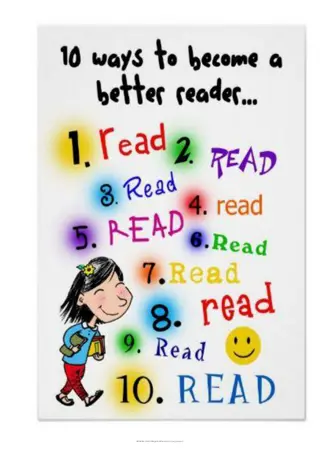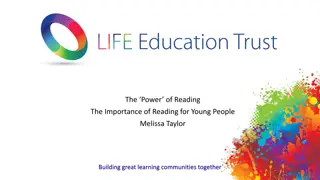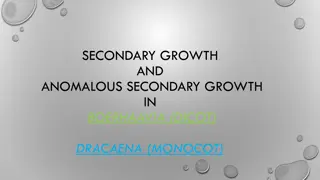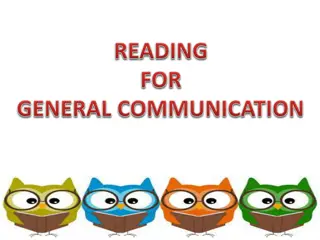Addressing the Science of Reading in Secondary Education
Press reports suggest schools are not prioritizing foundational reading skills, impacting students' reading proficiency in all grades. Addressing this gap is critical for boosting literacy achievement from Grades 6 to 12, emphasizing the importance of foundational skills alongside comprehensive text reading and comprehension strategies.
Download Presentation

Please find below an Image/Link to download the presentation.
The content on the website is provided AS IS for your information and personal use only. It may not be sold, licensed, or shared on other websites without obtaining consent from the author.If you encounter any issues during the download, it is possible that the publisher has removed the file from their server.
You are allowed to download the files provided on this website for personal or commercial use, subject to the condition that they are used lawfully. All files are the property of their respective owners.
The content on the website is provided AS IS for your information and personal use only. It may not be sold, licensed, or shared on other websites without obtaining consent from the author.
E N D
Presentation Transcript
Science of Reading and Secondary Education Timothy Shanahan University of Illinois at Chicago www.shanahanonliteracy.com
Current Controversies Press and media have reported that schools are ignoring the science of reading What they seem to mean by this is that research reveals the importance of foundational skills (particularly phonics) and that many elementary schools have adopted programs that either don t include the teaching of such skills or they minimize such teaching and make it unnecessarily confusing There is more to teaching reading than foundational skills, of course, but foundational skills are important. Addressing this need in the early grades makes sense
An examination of results from the National Assessment of Educational Progress indicate that students in the U.S. lag in reading not just in Grade 4 but in Grades 8 and 11, too But what about the secondary grades? Past results suggest that improving reading in the primary grades has little impact on how older readers do If we want to improve literacy achievement in Grades 6-12, we must address that directly
Teachers usually can see the value of having students read text with teacher guidance and support (e.g., guided or directed reading, close reading) But what about the secondary grades? (cont.) Such work obviously is connected to reading comprehension since the students are practicing comprehending high-quality text with teacher assistance But what of those foundational skills? Is much instructional time and effort devoted to those and should it be?
Overview of Literacy Skills Overview of Literacy Skills Elementary Phonemic Awareness Phonics/Decoding Structure & Syllabication Sight Vocabulary/High Freq Words 140 wcpm Language (vocabulary, syntax, cohesion) Text structure Cognitive strategies Purposes (Narration, Exposition, Argument) Products Processes (Prewriting, Drafting, Revision, Editing) Audience Secondary Word Knowledge Morphology Structure & Syllabication Text Reading Fluency 150 wcpm Reading Comprehension Language (vocabulary, syntax, cohesion) Text structure Disciplinary strategies Writing Purposes Products Processes Audience
The idea of phonics is to teach students to read words by decoding the sound-symbol relationships and spelling patterns Research has found that teaching decoding explicitly to students in grades K-2 improves reading achievement Secondary Phonics? There are decoding and spelling skills that go beyond these levels, but it is presumed that these don t require a great deal of instructional attention in the upper elementary grades Reading authorities usually have discouraged decoding instruction in the secondary grades in special education (students with severe disability) as such phonics would not be something for us to explore here
However, research is revealing some important things about the decoding abilities of secondary students Educational Testing Service (ETS) tried to determine if there were threshold levels of foundational skills that students needed to meet if they were to make progress in reading in grades 6-12 (Wang, Sabatini, O Reilly, & Weeks, 2019) Secondary Phonics? (cont.) Tested more than 10,000 students grades 5-10 and identified a threshold level of literacy -- if students decoding abilities were below this threshold, these skills had no relation to reading comprehension (ETS READBASIX) Longitudinal study of the comprehension growth of 30,000 students found that students below the decoding threshold made no growth in reading comprehension over the next 3 years (Grades 6-12) no matter the instruction
A surprising finding was the large numbers of students who fell below the threshold In the ETS sample (which was not nationally representative), 38% of the fifth graders and 19% of the 10thgraders failed to reach the threshold much higher than expected Secondary Phonics? (cont.) It is important that your feeder schools are providing sufficient amounts of high-quality decoding instruction in grades K-4/5 (students above the threshold made strong gains in comprehension from a wide range of instruction) It is important that secondary schools identify these students and try to meet their decoding needs
Even with these provocative results, it would not make sense for classroom English Language Arts teachers to try to meet these students decoding needs Secondary Phonics? (cont.) No, it would make more sense for that to be done in special education or in special reading classes However, given the surprising numbers of students identified in this study and the results of some morphology research, it would make sense to provide classroom instruction aimed at helping students to analyze words and think about their structure through morphology (Grades 6- 12)
Meta-analysis of 79 studies found that morphology instruction had positive impacts on literacy achievement, phonological awareness, vocabulary, reading comprehension and spelling (Goodwin & Ahn, 2010) Morphology Morphological knowledge contributes to reading comprehension beyond the effects of vocabulary alone Morphological instruction was particularly effective for students with reading, learning, or speech and language disabilities, English language learners, and struggling readers, suggesting the possibility that morphological instruction can remediate phonological processing challenges.
Morphology is the study of words, how they are formed, and their relationship to other words in the same language. It analyzes the structure of words and parts of words such as roots, combining forms, prefixes, and suffixes. Morphology (cont.) Although the focus of morphology instruction tends to be heavily focused on word meanings, it also addresses issues of syntax and how words are structured to play meaningful roles in sentences, and spelling/word construction which may support decoding progress.
Morphemes are the smallest units of a word that carry meaning Inflectional morphemes (e.g., suffixes that change tense or number, such as plural markers) Morphology (cont.) Derivational morphemes (e.g., prefixes, suffixes that alter form and/or meaning, such as un or ed ) Roots (free standing roots like table or bound roots like liter )
Morphology (cont.) The majority of studies of morphology instruction have focused on teaching prefixes and suffixes (their meanings, their syntactic qualities, how they combine with roots, etc.) As students learn more of these affixes their knowledge of vocabulary increases and their ability to recognize syntactic relationships within sentences improves Emphasis of instruction is on memorizing the affixes, examining their meaning across several words, and guiding students to use their word solving skills with words in text that they are reading (comprehension), spelling and syllabication (decoding), and identifying their role in sentences (syntax)
40 Most Common Suffixes 40 Most Common Suffixes Suffixes for Adjectives Meaning Example -able capable adaptable capable of adapting -ary relating to solitary relating to solitude -er more bigger more big -est most smallest the most small -ful full of; having wonderful having the ability to inspire wonder -ible capable terrible capable of causing terror -ic relating to poetic relating to poetry -ish characteristic; quality childish having the characteristics of a child -less without meaningless without meaning -like characteristics or similarities to lifelike sharing similarities with something alive -ous having the qualities of cautious having qualities of caution -y made up or characterized by fruity made up of fruit or a fruit flavor
40 Most Common Suffixes (cont.) 40 Most Common Suffixes (cont.) Suffixes for Nouns Meaning Example -age the action or process of passage the action of passing through -al act; process of refusal the act of refusing -ant a person who servant a person who serves -cracy power or rule democracy rule by the people -dom place; state of being kingdom place where the king rules -er person who carpenter person who does carpentry -ess female lioness female lion -ette smaller kitchenette small or partial kitchen -hood state of motherhood state of being a mother -ion the action of celebration action of celebrating -ism belief communism belief in communal society -ity having the quality of activity quality of being active
40 Most Common Suffixes (cont.) 40 Most Common Suffixes (cont.) Suffixes for Nouns Meaning Example -log speech dialog speech between two people -ment the action or result of enchantment the result of enchanting -ness state of being sickness state of being sick -or person who actor a person who acts -ship position citizenship position of citizen of country -th quality depth having the quality of being deep -ure condition failure condition of having failed
40 Most Common Suffixes (cont.) 40 Most Common Suffixes (cont.) Suffixes for Verbs Meaning Example -ize become civilize to become civil -en to become soften to become soft -ify to make or become simplify to make simple
40 Most Common Suffixes (cont.) 40 Most Common Suffixes (cont.) Suffixes for Adverbs Meaning Example -ward direction toward in the direction of
40 Most Common Suffixes (cont.) 40 Most Common Suffixes (cont.) Suffixes for Adjectives/Nouns Meaning Examples -ac related to cardiac related to the heart (adj) maniac related to mania (noun) -an relating or belong to American from or belonging to the continent of America or the United States (adj) mathematician related to or belonging to the field of mathematics (noun)
40 Most Common Suffixes (cont.) 40 Most Common Suffixes (cont.) Suffixes for Nouns/Verbs Meaning Examples -cycle circle bicycle a vehicle with two circular wheels (noun) recycle a circle of reusing resources (verb) -eer engaged or involved in; a person who is engaged or involved in volunteer person engaged in voluntary activities (noun); the act of engaging in voluntary activities
40 Most Common Suffixes (cont.) 40 Most Common Suffixes (cont.) Suffixes for Adjectives/Adverbs Meaning Examples -wise direction clockwise in the direction the clock moves lengthwise in the direction of the length, not the width
50 Most Common Prefixes 50 Most Common Prefixes Prefixes Meaning Example a-, ab- without, now Ahistorical, abnormal, atypical ab- away absent, abdicate ad- to, forward advance, admit ante- before antecedent, antebellum anti- against antisocial, antipathy auto- self autonomy, autocracy circum- round, around circumvent, circumference com-, co-, con with, together compact, confluence contra-, counter- against counteract, contrary de- down, off, reversed deconstruct, descend, derail
50 Most Common Prefixes ( 50 Most Common Prefixes (cont cont) ) Prefixes Meaning Example dia- through dialogue, diagnose dis- not disjointed, dissent e- out of eject, edict en- put into, cover envelope, enclose ex- out of, from excavate, extract equi- equal equity, equidistant extra- above, outside extraneous, extravagant hetero- different heterogeneous, heterodox homo- same homonym, homogenous Hyper- over hyperactive, hypersensitive
50 Most Common Prefixes ( 50 Most Common Prefixes (cont cont) ) Prefixes Meaning Example il- not illegitimate, illegal im- not impossible, immoral in- In, not inspect, invisible intra- within intravenous, intrastate inter- between, among international, intervene ir- not irresponsible, irreverent magni- large magnitude, magnificent micro- small microscope, microwave mis- wrong misunderstood, misfit mono- one monologue, monopoly
50 Most Common Prefixes ( 50 Most Common Prefixes (cont cont) ) Prefixes Meaning Example multi- many multicolored, multiply neo- new Neophyte, neologism non- not nonfiction, nonconformist ob- against obstruct, obstinate over- too much overestimate, overkill pan- all panacea, pandemonium per- through pervade, permit peri- around perimeter, periscope poly- many polyglot, polygon post- after postpone, postmodern
50 Most Common Prefixes ( 50 Most Common Prefixes (cont cont) ) Prefixes Meaning Example pre before preplan, previous pro- forward progress, promote pseudo- false pseudonym, pseudointellectual re- again, back revisit, reject, return retro- backward retrospective, retrograde sub- under submerge, subject super- over supernatural, superb sym-, syn- with, together symphony, synthetic trans- across transatlantic, transport un- not unsuccessful, unnatural
Word Matrix Word Matrix s er ed ing age ing ed re et s pack un mis auto
Morphology (cont.) Morphology (cont.) Some research with middle school and high school students has successfully focused on teaching Latin bound roots ben good benefit, beneficial, benevolent, benefactor, benediction min small minority, minute, minimum, minor, diminish nov new innovative, renovate, novice, novelty Significant gains for students at all grade levels (especially high school)
Word Knowledge Word Knowledge We usually think of instruction aimed at decoding, syllabication, and spelling of words as something for the elementary grades However, this kind of word structure instruction addresses those same issues, but with much more complicated/ sophisticated words, and with a closer or more direct tie to text interpretation Teaching these foundational aspects of literacy are an important aspect of English and literature studies
Text Reading Fluency Text Reading Fluency Text reading fluency refers to the ability to read text accurately, with automaticity, and prosody By 8th grade, average students can read text aloud at about 150 wcpm and with the sound of language (e.g., pausing in the right places) Fluency explains about 25% of the variation in comprehension getting all students up to this level of text reading fluency will have a strong impact on reading comprehension
Text Reading Fluency (cont.) Experience tells me the most effective approach with middle and high school students is paired reading with teacher supervision National Reading Panel found teaching text reading fluency improved reading achievement Grades 1-12 Reading challenging texts aloud, with feedback, and repetition had a positive impact on reading comprehension
Text Reading Fluency (cont.) Study of high school reading random assignment to 2 groups; one group takes a standardized reading test and the other does too, but with the text parsed, showing where the pauses are The second group, according to the test, reads at a full grade level higher than the first group Parsing is powerful
Text Reading Fluency (cont.) Another high school study has an experimental group engaged in three activities: (1) reading parsed text aloud; (2) parsing text and reading it aloud; and (3) reading text as if it was parsed. Those students made substantial gains in reading comprehension
Text Reading Fluency (cont.) In Chicago, I mandated word knowledge, text reading fluency, reading comprehension, and writing instruction K-12 for 437,000 (more than 100,000 secondary students) We raised reading achievement significantly Unlike most interventions/educational reforms, we saw bigger gains in grades 4-12 than grades K-3
Why should we teach foundational skills? Teaching students how to think with disciplinary texts is important and Study Sync does that well Knowing how to think like an English professor when reading literature is valuable If you re serious about accomplishing this then it is necessary to teach how language works how words and sentences exert meaning Foundational skills teaching is part of the science of reading, even in secondary grades)
Science of Reading and Secondary Education Timothy Shanahan University of Illinois at Chicago www.shanahanonliteracy.com























